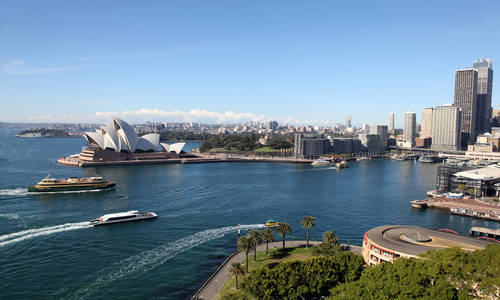Article content
5 November 2019 by Eleanor Kania
Given its size, Australia is a year-round destination, with different regions coming into their own in different seasons. In short, although you’ll have your pick of hot summers and delightfully temperate shoulder seasons in the south, look to the winter to avoid the heat of the Red Centre and the rains of the tropical north. Remember though, the seasons are flipped with the hemispheres – ideal for grabbing some summer sun away from the British winter. Read on for further details.
Australian Summer (December to February)
Swapping hemispheres is the perfect way to enjoy some winter sun. After all, it’s the Australian summer, with endless days of sunshine spread across the country’s south, from Sydney and Melbourne to the Gold Coast and Perth’s vineyard surrounds. Just remember, temperatures will be high and this is among the busiest times to travel. So, consider heading more off the beaten track, perhaps to the Tasmanian wilderness. Lastly, there’s also all the signature fun of an Australian summer, with the likes of world-class cricket, grand-slam tennis and a full range of outdoor cultural events.

Sydney Harbour from above
Autumn (March to May)
With the weather less intense and the school-holiday crowds subsiding, the autumn shoulder months are one of our favourite times to travel to Australia. The south is again particularly good, with the outdoor activities on offer a special highlight. Head out for a walk in the Blue Mountains, cycle along beach-fringed coast or try your hand at white-water rafting on Tasmania’s west coast. Following the busy summer harvest, it’s also a great time of year for wine and food tastings, with cellar-door festivals springing up across the country. Melbourne’s Grand Prix is another big draw.

Adelaide vineyard in autumn
Winter (June to August)
Winter is when the Red Centre come into its own. With the blistering summer sun a distant memory, the delights of the Outback open up; its Uluru icon and Aboriginal heritage are obvious highlights. Escaping the humidity and monsoons, it’s also an ideal time to visit the tropical north, whether you’re snorkelling in the Great Barrier Reef, spotting kangaroos in Kakadu National Park or exploring the wonders of the Daintree Rainforest. There’s also the opportunity to watch the whale migration across Australia, while the oh-so-mild winters mean that it’s still very possible to explore the south. For example, daytime temperatures in Sydney rarely dip below 16°C.

The iconic Uluru in the Red Centre
Spring (September to October)
Before November’s rains arrive, spring is still a great time to visit the north, perhaps mixing in some time on the beach in between the region’s natural wonders. Trekking in the UNESCO-listed Daintree Rainforest is particularly good. Otherwise, spring offers much of the same shoulder-season charms as autumn, with fewer crowds paired with good, temperate weather. Perhaps combine world-class wines with coastal beauty in Margaret River or jazz festivals in Hunter Valley before checking out the hopping eponyms of Kangaroo Island and the blooming gardens of Tasmania.

Kangaroo Island
Inspired? Take a look at our selection of itineraries below, or get in contact to start planning your ideal Australian holiday.




